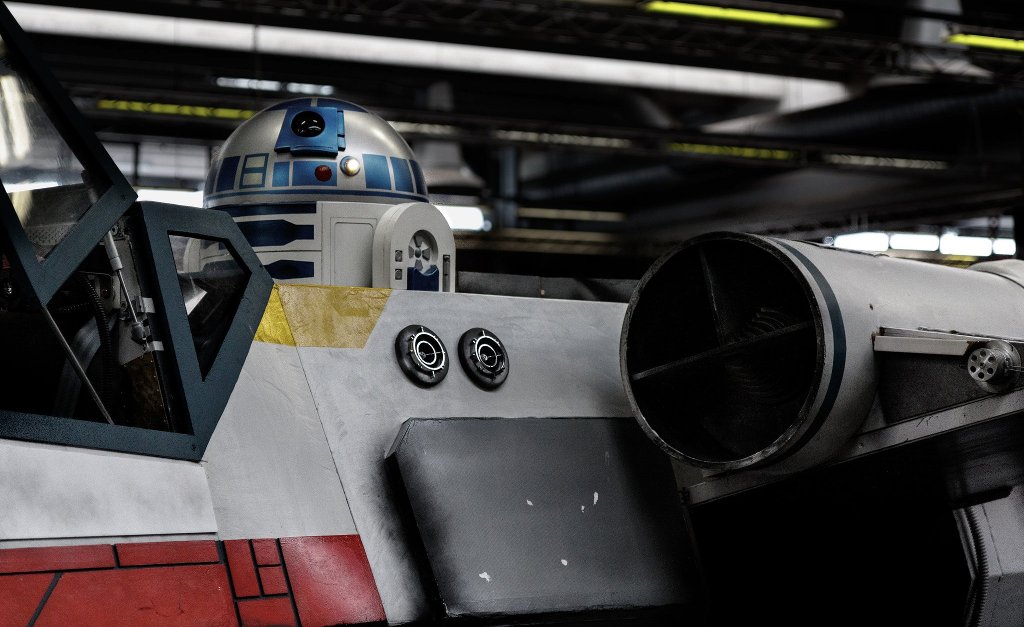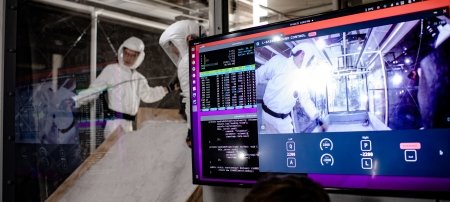We asked Michigan Tech researchers about the science of Star Wars. After all, it would take a serious team of engineers to build the Death Star. But there’s also the matter of sound in space, Tatooine’s stars, and what a blaster means for culture. Here’s what our researchers say about sci-fi science.
Could We Build a Death Star—For Good, of Course?
To answer, we call on R. Andrew Swartz, an assistant professor in civil and environmental engineering who researches the application of computationally efficient and robust embedded algorithms for monitoring and protecting infrastructure like buildings, bridges, pipelines, wind turbines, roadways, and railroads.
How structurally feasible is it to build a Death Star?
R. Andrew Swartz (AS): The design of a battle station that is the size of a small moon presents some interesting structural engineering challenges. First and foremost is the understanding of the structural loads involved. Terrestrial structures are subject to both gravity and lateral loads, requiring structural support systems designed to carry both. In the case of the Death Star, the structure itself is so significantly massive (a 120-km-wide, semi-hollow sphere made of quadanium steel) that it may be its own source of gravity. In addition, structures have lateral-load systems to resist forces and pressures that act perpendicular to the pull of gravity; on Earth, these are primarily seismic and wind loads. The Death Star, being located in space, is free from such loads. But, it would be subject to significant inertial loads during maneuvers both within a solar system (powered by the station’s many ion sublight engines) and between systems (while using the hyperdrive). A combination of traditional structural systems might be employed to resist these forces, including moment frames, vertical truss systems, (quadanium) steel shear walls, and even thin-shell construction techniques. Thin being a relative term in this case.
Which Star Wars technology would be especially helpful in solving today's structural engineering problems?
AS: One of the most useful and exotic technologies depicted within the Star Wars universe may provide a better alternative for the challenges listed above: their mastery of gravity. Nearly all Star Wars vessels, regardless of size or configuration, provide to their occupants an artificial gravity source that is entirely consistent with an Earth-based movie shoot that lacks either the budget or inclination to simulate freefall. Other in-universe gravity manipulating technologies form the basis of other prominent devices including repulsorlifts and landspeeders. These technologies could be employed in a structure as large as the Death Star to prevent its components from collapsing in upon themselves. Such a system would naturally incur some risk.
Could you address some of these challenges using the smart sensors you are developing in your research?
AS: To mitigate this kind of risk, a sophisticated feedback control system with pervasive sensing technology would be required in order to keep the system in stable. Also, the particle accelerator tubes that make up the station’s main superlaser armament would have to be kept in close alignment. Contemporary terrestrial structures that possess sensing and feedback control systems are referred to as “smart” structures. These represent a promising approach for reducing terrestrial load effects as well as enhancing occupant safety and comfort, even without access—yet—to gravity manipulation technology. As new technologies are developed, one would hope that our future structural engineers will abide by their ethical duties to “hold paramount the safety, health, and welfare of the public and shall strive to comply with the principles of sustainable development in the performance of their professional duties.” And that they are politically engaged and informed enough not to be taken in by the Empire’s public description of the Death Star as the “Imperial Planetary Ore Extractor.”
References: Wookieepedia, ASCE Code of Ethics
"As new technologies are developed, one would hope that our future structural engineers will abide by their ethical duties."R. Andrew Swartz

What Does a Spaceship Really Sound Like?
Andrew Barnard is an assistant professor in mechanical engineering-engineering mechanics and researches acoustics, noise control, and vibration.
In your expert opinion, which Star Wars ship has the most realistic sound?
Andrew Barnard (AB): I think the most accurate sound effects are for the vehicles that operate in the atmosphere of a planet. Since sound can't propagate in space (more to come later), the sound effects of the spaceships are completely made up. Some of the ships in Star Wars, like the famous X-wing fighters of the rebel army, are designed to operate in space as well as in a planet's atmosphere. These ships would have a sound signature when in an atmosphere, but would not generate sound in space. Also, it's interesting that these types of ships make the same sounds on different planets. Presumably, each planet has a different atmospheric make-up of gasses, pressure, density, temperature, and wind velocities. All of these parameters change the speed of sound and the atmospheric absorption of sound that, in turn, change the way that something sounds from a distance. Back to the question: I would say the AT-AT (or Imperial Walkers) from The Empire Strikes Back probably have the most realistic sounds. That's because they are huge mechanical walking ships that have lots of creaking and grinding sounds in between the thumps of the foot pads on the ground. That seems plausible based on the presumed types of mechanical systems in the powertrain of the AT-AT.
What is the source of the TIE fighter's sound?
AB: The source of the TIE fighter sound would be its engines. However, in space, there would be no sound propagation, so it really shouldn't have a sound at all. If you listen closely to the TIE fighter, you hear the frequency change, from high frequency to low frequency, as it flies by a fixed camera position. This is a depiction of the Doppler effect. When the source is quickly moving towards the listener location, the wavefronts of sound compress slightly, increasing the received frequency by the listener. When the source is moving away from the listener, the wavefronts of sounds expand slightly, which decreases the frequency of the sound. This is the same effect you experience when a police vehicle or ambulance passes you on the highway. When the TIE fighter is directly in front of the camera position, that is the "true" frequency of the engine. Assuming it would actually make noise, which, of course, it doesn't.
Why wouldn't there be sound in space?
AB: Now we get to the most important point. There can be no sound propagation in space. In order for sound to propagate from a source to a receiver, there must be a path. In a fluid (air, water, etc.), the particles of the fluid oscillate due to the vibration of a source. Then adjacent particles begin to oscillate due to particle collisions in the fluid medium. This successive chain of oscillation and collision of fluid particles is what allows a sound wave to move from a source to a receiver. In space, there is no fluid medium with particles; it is essentially a vacuum. So any vibration, or other potential sound generating source, cannot transfer energy through space to a receiver—meaning no sound. Although those laser blaster sounds are really cool when Luke is blowing up the Death Star, that scene would be more acoustically accurate in a silent film starring Buster Keaton or Charlie Chaplin.
Lastly, if you could choose, which Star Wars vehicle would you take a ride in and why?
AB: I think that any self-respecting Star Wars fan would have to choose the Millennium Falcon, right? No one does the Kessel Run faster. And hanging out with Han and Chewy would be a trip. Plus, as an engineer, there are always plenty of things to fix on the Falcon. A close second choice would be the Delta-7 Jedi Starfighter.
"Although those laser blaster sounds are really cool when Luke is blowing up the Death Star, that scene would be more acoustically accurate in a silent film starring Buster Keaton or Charlie Chaplin."Andrew Barnard

How Does Tatooine Have Two Stars?
Let’s talk about planets and stars for a moment with Teresa Wilson, a graduate student studying physics at Michigan Tech.
How does a binary star system like the twin suns of Tatooine work?
Teresa Wilson (TW): A binary star is a star system of two stars orbiting about a common center of mass. It is estimated that one third of the stars in the Milky Way are part of a binary or multiple star system. While detecting planets in binary star systems is difficult, it is not impossible for them to exist, although the possibility of orbital ranges is largely decreased. They may either orbit a single star or the entire system, and the presence of a binary companion is widely thought to increase planet formation. It is also thought that 50-60 percent of binary systems are capable of supporting habitable planets, so the scenario of Tatooine is not unrealistic.
Can you explain a "mass shadow" and why the ships of Star Wars must avoid them while traveling the universe?
TW: The "mass shadow" is the gravitational signature of a large object such as a planet in space. Since going within the mass shadow of an object would pull you within its orbit, avoiding it would be critical when making the jump to hyperspace.
Are the Star Wars planets similar to real planets? And which would you visit?
TW: All of the Star Wars planets bear a striking resemblance to places right here on Earth! It's really quite amazing. For visiting, I think Takodana—where the diminutive pirate queen Maz Kanata rules—would be a cool place to go.Takodana—where the diminutive pirate queen Maz Kanata rules—would be a cool place to go.
"It is also thought that 50-60 percent of binary systems are capable of supporting habitable planets, so the scenario of Tatooine is not unrealistic."Teresa Wilson

Finally, let's consider the societal and cultural implications of Star Wars tech.
Laura Kasson Fiss is an instructor of English and researches the history of the book, fan culture, and humor, particularly in Victorian Britain.Kasson Fiss is an instructor of English and researches the history of the book, fan culture, and humor, particularly in Victorian Britain.
Andrew Fiss is an assistant professor of technical and professional communication, and researches cultural understandings of math and science.
How do sci-fi and science interface and inspire each other?sci-fi and science interface and inspire each other?
Andrew Fiss (AF): It seems like fiction and science intersect in how they imagine different worlds. The Star Wars universe, of course, contains various planets with different creatures, but powerful worlds can also be created through stories of life on a single planet or even on a single sheet of paper, as in the book Fiss (AF): It seems like fiction and science intersect in how they imagine different worlds. The Star Wars universe, of course, contains various planets with different creatures, but powerful worlds can also be created through stories of life on a single planet or even on a single sheet of paper, as in the book Flatland. Science, especially as it's taught in classrooms, contains a similar envisioning of worlds with slightly different rules: the earth without friction, proteins with simplified structures. Imagining different worlds allows us to ask: what's our world like—and why?like—and why?
Laura Kasson Fiss (LF): One of the striking things about fiction, and science fiction and fantasy in particular, is their creation of fan communities. Science fiction and fantasy provide a particularly intense version of world-creation, with their terminologies, rules, and histories forming a shibboleth to bond strangers (and provoke friendly one-upsmanship among friends). I think it's no accident that two significant founders of the genre were a linguist (J.R.R. Tolkein) and a mathematician (Lewis Carroll). Their worlds, as Andy said, depend on rules. Part of the distinction between fantasy and science fiction often has to do with the plausibility of those rules, but both depend on a notion of logical consistency. Kasson Fiss (LF): One of the striking things about fiction, and science fiction and fantasy in particular, is their creation of fan communities. Science fiction and fantasy provide a particularly intense version of world-creation, with their terminologies, rules, and histories forming a shibboleth to bond strangers (and provoke friendly one-upsmanship among friends). I think it's no accident that two significant founders of the genre were a linguist (J.R.R. Tolkein) and a mathematician (Lewis Carroll). Their worlds, as Andy said, depend on rules. Part of the distinction between fantasy and science fiction often has to do with the plausibility of those rules, but both depend on a notion of logical consistency.
What are some of the most influential scientific discoveries of science fiction (thinking relativity, artificial intelligence—big picture stuff)?intelligence—big picture stuff)?
AF: I think the developments in non-Euclidean geometries inspired and continue to inspire a surprising amount of science fiction. The recognition that geometrical rules work differently on different surfaces led to abstract mathematics and relativistic physics as well as to linguistic games and psychological studies of human experience. After all, an early work partially inspired by non-Euclidean geometries was Euclidean geometries inspired and continue to inspire a surprising amount of science fiction. The recognition that geometrical rules work differently on different surfaces led to abstract mathematics and relativistic physics as well as to linguistic games and psychological studies of human experience. After all, an early work partially inspired by non-Euclidean geometries was Alice's Adventures in Wonderland, and it leaves a long legacy on the science fiction genre, though that's not always acknowledged.
LF: Carroll certainly demonstrates that not all rules are consistent, and even the notion of rules can at times be laughable. Some Carroll scholars try to codify his nonsense, finding mathematical patterns in Alice's failure to recite her multiplication tables, for instance. I'd argue that instead Carroll points out the ways in which rules fail. The multiplication table doesn't always work; rules don't always represent reality. Too rigid a reliance on rules is not actually productive for scientific thinking.
What is a technology that was inspired by science fiction?
AF: I think fiction influences technology not through a direct development but through an overall approach. The works of Philip K. Dick, Ursula K. Le Guin, George Lucas, and many others show how separating technology and society is not such an easy matter. The politics of Star Wars, for instance, cannot be separated from interplanetary travel or sentient droids. In these stories, technologies and societies shape each other.
Are there any scientific discoveries since the first Star Wars movie in 1977 that change the way the Star Wars universe is imagined?
AF: Since 1977, the interrelation between real technologies and societies has received sustained attention in a variety of institutions and countries, and that interplay can show up in fiction, too. So, the new Star Wars stories have to present the complications, not just a story of good and evil. As we saw in Episode VII, storm troopers have been shaped through an amalgam of religion, politics, and tech, and this meshing makes their work/life especially difficult to escape.
Lastly, if you could choose any Star Wars tech to incorporate into your life, what would it be?
LF: If I could choose an element of Star Wars to incorporate into my life, it wouldn't be a piece of technology as such; it would be the Force. Who wouldn't want to be able to get an object from across the room without getting up? But seriously, the notion of being connected to all living things is very attractive. And I think that's part of what makes the Star Wars universe particularly inspiring. In addition to the flashy tech and the innovative film cutting, Lucas taps into notions of balance and counterposes technology with spirituality. He studied Jungian archetypes, particularly through the work of Joseph Campbell.
Fundamentally, the original Star Wars trilogy is a cautionary tale about the uses of technology. Alderaan—which was blown up by the Death Star—resembles the “Whole Earth” photograph taken by NASA in 1972. At the time, the Cold War was still palpable. Mutually assured destruction seemed a possibility. I think that's one of the biggest changes in the way the Star Wars universe is imagined. The notions of global threat have shifted significantly, and at the same time the genre of the action movie has ramped up the narrative stakes. In Episode IV, the bad guys destroy a planet as a mark of their utter moral depravity. In Episode VII, the good guys destroy a plant to save a solar system—a calculated risk.
"Who wouldn't want to be able to get an object from across the room without getting up? But, seriously, the notion of being connected to all living things is very attractive."Laura Kasson Fiss

Michigan Technological University is an R1 public research university founded in 1885 in Houghton, and is home to nearly 7,500 students from more than 60 countries around the world. Consistently ranked among the best universities in the country for return on investment, Michigan's flagship technological university offers more than 185 undergraduate and graduate degree programs in science and technology, engineering, computing, forestry, business, health professions, humanities, mathematics, social sciences, and the arts. The rural campus is situated just miles from Lake Superior in Michigan's Upper Peninsula, offering year-round opportunities for outdoor adventure.






Comments